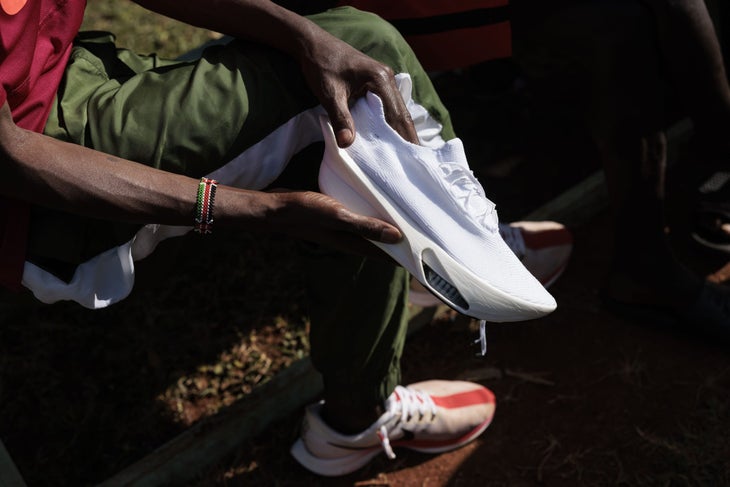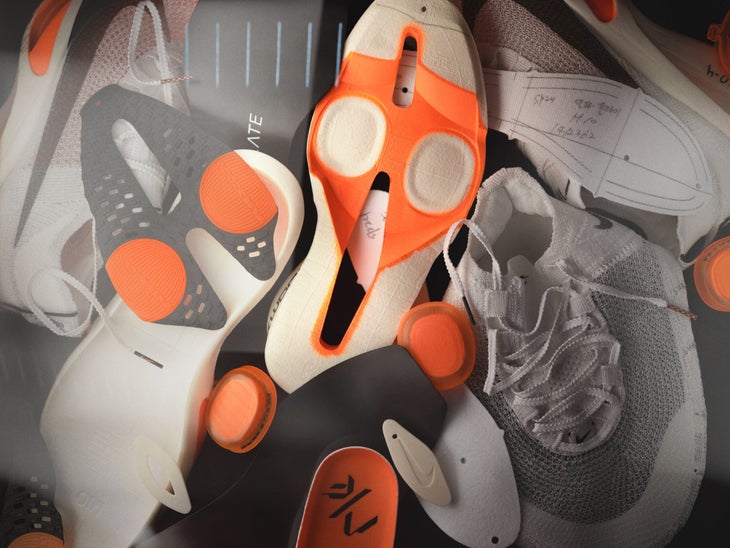New perk: Easily find new routes and hidden gems, upcoming running events, and more near you. Your weekly Local Running Newsletter has everything you need to lace up! Subscribe today.
As Kelvin Kiptum raced towards the finish line of the Chicago Marathon this fall, all eyes were glued to the clock. But as soon as the 23-year-old Kenyan runner officially shattered the men’s marathon world record with a time of 2 hours 35 seconds, those eyes immediately turned to his shoes.
On his feet were the long-awaited Nike Alphafly 3, which go on sale January 4, 2024.
Nike Alphafly 3
Nike calls the third iteration of this super shoe a refinement, but (visually, at least) it’s more of a revamp—one that was influenced by the largest ever women’s testing pool for a Nike racing shoe, says Bret Schoolmeester, Nike’s Senior Footwear Director.
“One of the things we’ve noticed across our running line, and with this shoe in particular, is the ability of our female testers to give us more articulate and harsher feedback—it’s kind of a secret weapon for us to make even better products,” explains Schoolmeester. “Comfort, stability, and transition were areas where our female testers really held us to a higher standard, and all of our runners are reaping the benefits of them calling those areas out.”
Even better: Those factors are all held at a higher premium for people further back in the pack, which makes the Alphafly 3 a viable option for runners of all paces.

Tested By Women, for Women (and Everyone)
If you think this version of the Alphafly looks more like the Vaporfly, you’re not wrong. “The first thing we did was flesh out the midfoot to make sure it’s a full, continuous bottom and adjust the last to have a more filled-in arch for more midfoot support,” says Schoolmeester. More arch support gets rid of some of the irritation some athletes might feel in that area, especially during later miles in a marathon.
That continuous bottom connecting the heel and forefoot also allows for a smoother heel-to-toe transition at any pace, says Schoolmeester. Personally, I didn’t have any issues in the Alphafly 1 or 2, and I didn’t notice much of a difference during a few short testing runs in the 3. Schoolmeester says the transition benefits may not show up in testing, “but as your form breaks down later in a race, having that level of support is only going to help you grind out those last six miles even better.”

The cutaway at the arch in the previous designs partially existed to cut weight. But even with the continuous bottom, the Alphafly 3 is 15 percent lighter than the Alphafly 2. A big reason for that is the ZoomX foam. “ZoomX is a compression foam, so we take it from a large sheet and compress it down into its final part size,” explains Schoolmeester. “Obsessing over the quality and compression ratio of that pre-form to final part is one of the ways we increase that soft, comfortable feeling and reduce weight.”
You still get that legal-for-competition 40-millimeter stack height, but even more weight was shed in the reductive midsole geometry in the midfoot and heel, where foam was sculpted out while still ensuring a stable footstrike. This construction optimizes your foot’s engagement with the Air Zoom units in the forefoot, so you really feel that forward propulsion with every step (I felt like I was wearing moon boots during my first mile).
“That optimization comes from how much foam is above versus below the carbon plate, how the plate is oriented, and the PSI [pounds per square inch, a measurement of pressure] of the Air Zoom units,” says Schoolmeester. “We don’t have new ingredients, necessarily, but it was really about optimizing how all those things worked in concert.” The way the overall system has been tuned especially benefits female runners, who tend to be lighter; the new configuration allows them to fully activate those Air Zoom units and take advantage of the compression and energy return, Schoolmeester explains.
RELATED: 9 Rules for Training in Supershoes

New Gains, No Added Weight
Of course, a big ingredient in the shoe is the stiff carbon plate, which helps the foam midsole compress and expand faster, allowing for more reactivity and energy return. Carbon plates also help stabilize foams, and in the Alphafly 3, the carbon Flyplate is wider on the medial side in the midfoot to further improve stability. Overall, the shoe looks wider and feels much more stable than the original version, especially on turns.
To counteract more material underfoot, Nike was able to shed weight on the upper and the outsole. Up top, a new Atomkit 3.0 upper offers breathability and midfoot support using lighter and softer Flyknit yarns for less rigidity and rubbing, and a redesigned lacing system for a noticably softer fit. On the bottom is a new Fast Shot outsole. It’s thinner than in the Alphafly 1, but, along with a few millimeters of ZoomX foam (as introduced in the Alphafly 2), better protects the Air Zoom units.
“The Fast Shot outsole is one of the bigger levers we had to pull to reduce height and weight on the outsole while still maximizing traction,” says Schoolmeester. I found it noticeably stickier than the previous iterations—even when navigating wet and icy patches on one test run.

It’s a thinner outsole, but many running shoes are weighed down by overly built rubber bottoms that outlast the midsole. “We really found that edge to where we can minimize it to the point of the whole shoe wearing out at the same rate,” Schoolmeester says.
And before you start shouting about single-use shoes, know that the Alphafly is not meant to be worn for just one race. Obviously, durabilty depends on size, how you run, where you run, and a whole host of different factors, so it’s hard to set a recommended mileage. “But we had testers taking it up to 200, 250 miles and still finding that it’s delivering a lot of magic,” says Schoolmeester. “We don’t feel like we’ve layered in any sacrifices to make this the best shoe possible.”
While the most obvious changes are visual, the fine-tuning of nearly every component of the Alphafly made this iteration even more enjoyable to run in than the last one. I felt the changes not only in how effortless my hard workout felt, but in how smoothly I moved during my easy runs—and I’m pretty confident that I’ll still feel that way when I take this shoe into higher mileage.
RELATED: Running Shoes of the Year 2023
